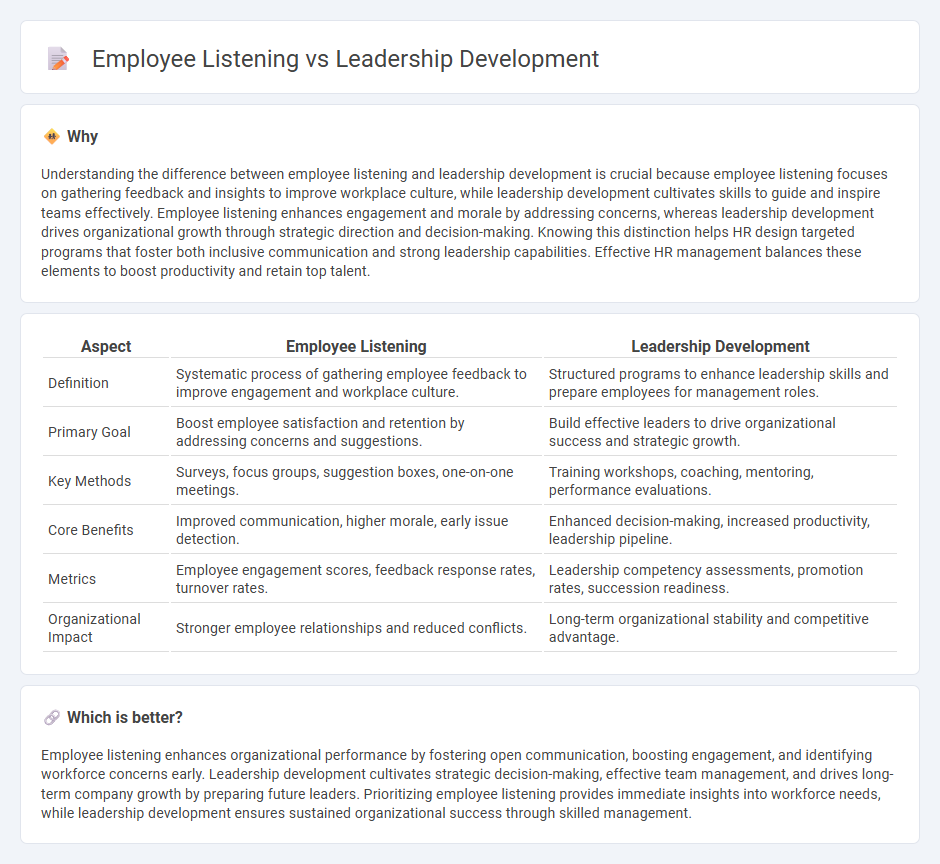
Employee listening enhances organizational insight by capturing workforce feedback and identifying areas for improvement, while leadership development focuses on cultivating skills and strategies within management to drive growth and engagement. Both approaches are essential for fostering a resilient, adaptive company culture that supports employee satisfaction and performance. Discover how integrating employee listening with targeted leadership development can transform your HR strategy.
Why it is important
Understanding the difference between employee listening and leadership development is crucial because employee listening focuses on gathering feedback and insights to improve workplace culture, while leadership development cultivates skills to guide and inspire teams effectively. Employee listening enhances engagement and morale by addressing concerns, whereas leadership development drives organizational growth through strategic direction and decision-making. Knowing this distinction helps HR design targeted programs that foster both inclusive communication and strong leadership capabilities. Effective HR management balances these elements to boost productivity and retain top talent.
Comparison Table
| Aspect | Employee Listening | Leadership Development |
|---|---|---|
| Definition | Systematic process of gathering employee feedback to improve engagement and workplace culture. | Structured programs to enhance leadership skills and prepare employees for management roles. |
| Primary Goal | Boost employee satisfaction and retention by addressing concerns and suggestions. | Build effective leaders to drive organizational success and strategic growth. |
| Key Methods | Surveys, focus groups, suggestion boxes, one-on-one meetings. | Training workshops, coaching, mentoring, performance evaluations. |
| Core Benefits | Improved communication, higher morale, early issue detection. | Enhanced decision-making, increased productivity, leadership pipeline. |
| Metrics | Employee engagement scores, feedback response rates, turnover rates. | Leadership competency assessments, promotion rates, succession readiness. |
| Organizational Impact | Stronger employee relationships and reduced conflicts. | Long-term organizational stability and competitive advantage. |
Which is better?
Employee listening enhances organizational performance by fostering open communication, boosting engagement, and identifying workforce concerns early. Leadership development cultivates strategic decision-making, effective team management, and drives long-term company growth by preparing future leaders. Prioritizing employee listening provides immediate insights into workforce needs, while leadership development ensures sustained organizational success through skilled management.
Connection
Employee listening enhances leadership development by providing leaders with critical insights into workforce needs, fostering a culture of trust and engagement. Effective feedback mechanisms enable leaders to adapt management styles, improve decision-making, and tailor development programs to employee concerns. This dynamic feedback loop strengthens organizational performance and drives continuous leadership growth.
Key Terms
**Leadership Development:**
Leadership development enhances organizational success by equipping leaders with strategic decision-making skills, emotional intelligence, and effective communication techniques. Investing in leadership programs fosters a culture of accountability, innovation, and resilience, driving long-term growth and employee engagement. Discover how targeted leadership development can transform your management approach and elevate team performance.
Succession Planning
Leadership development enhances succession planning by identifying and grooming high-potential employees for future leadership roles, ensuring organizational stability and growth. Employee listening provides critical insights into workforce needs, engagement levels, and emerging talent, which informs targeted leadership training and retention strategies. Explore how integrating leadership development with employee listening transforms succession planning and strengthens organizational resilience.
Coaching
Leadership development emphasizes coaching techniques that enhance decision-making, emotional intelligence, and team motivation to drive organizational success. Employee listening focuses on gathering authentic feedback, fostering open communication, and creating a culture of trust that empowers leaders to address team needs effectively. Explore how integrating coaching in leadership development with employee listening practices can transform workplace dynamics and performance.
Source and External Links
How to Create a Successful Leadership Development Program - Leadership development initiatives should align learning experiences with business goals, involve senior leaders, and use ongoing assessment and feedback to measure impact and foster a culture of continuous growth.
Leadership Development Meaning & Importance - peopleHum - Leadership development focuses on enhancing an individual's ability to lead and influence, often through programs like coaching (for confidence and perspective) and mentoring (for knowledge transfer and generational collaboration), supported by analytics and digital tools to personalize and track progress.
What Type of Leadership Development Is Right for You? - Leadership development is the process of acquiring and practicing leadership skills, is accessible to both new and experienced leaders, and includes programs that teach foundational, specialized, or a combination of leadership skills tailored to each participant's needs.
 dowidth.com
dowidth.com